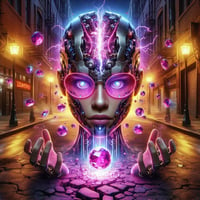In today's blog post, we delve into the intriguing realm of Artificial Intelligence and its...
Cyberpunk Aesthetic & the Quest for Humanity: From Ghost in The Shell to AKIRA
The Cyberpunk Aesthetic has long been a captivating vision of the future, blending high-tech advancements with a gritty, dystopian edge. This unique world view imagines a society where technology has integrated seamlessly into everyday life, yet also brings about a sense of isolation and disconnection. In this world, humanity is both enhanced and challenged by the constant evolution of technology.
One of the most iconic representations of the Cyberpunk Aesthetic can be found in the classic anime films, "Ghost in the Shell" and "Akira." These films explore the fusion of human consciousness with artificial intelligence, blurring the lines between man and machine. In both stories, characters grapple with questions of identity, existence, and the nature of the soul.
In "Ghost in the Shell," Major Motoko Kusanagi is a cyborg who struggles to define her own identity as she grapples with the concept of having a human soul inside of an artificial body. The film delves into themes of self-discovery, consciousness, and the potential consequences of merging human and machine.
Similarly, "Akira" follows the story of Tetsuo Shima, a young man who gains immense psychic powers after a mysterious encounter. As Tetsuo's abilities grow, he becomes increasingly disconnected from his own humanity, leading to a destructive rampage that threatens to consume him entirely. The film highlights the dangers of unchecked technological advancement and the consequences of losing touch with one's own humanity.
These films offer a thought-provoking exploration of the relationship between humanity and technology, raising important questions about the potential implications of merging human consciousness with artificial intelligence. While the concept of placing a human soul, or Awareness as it is known in Buddhism, inside an android body may seem far-fetched, it serves as a powerful metaphor for the complexities of our ever-evolving relationship with technology.
As we continue to push the boundaries of what is possible with artificial intelligence and cybernetics, it is essential to consider the ethical and philosophical implications of merging man and machine. The Cyberpunk Aesthetic challenges us to think critically about the future of humanity and the potential consequences of our technological advancements.
While the idea of placing a human soul inside an android body may be purely speculative, it serves as a reminder of the importance of maintaining our humanity in an increasingly technologically-driven world. As we navigate the complexities of the digital age, it is crucial to remember the value of human connection, empathy, and self-awareness in order to ensure a future that is both innovative and ethical.
One of the most iconic representations of the Cyberpunk Aesthetic can be found in the classic anime films, "Ghost in the Shell" and "Akira." These films explore the fusion of human consciousness with artificial intelligence, blurring the lines between man and machine. In both stories, characters grapple with questions of identity, existence, and the nature of the soul.
In "Ghost in the Shell," Major Motoko Kusanagi is a cyborg who struggles to define her own identity as she grapples with the concept of having a human soul inside of an artificial body. The film delves into themes of self-discovery, consciousness, and the potential consequences of merging human and machine.
Similarly, "Akira" follows the story of Tetsuo Shima, a young man who gains immense psychic powers after a mysterious encounter. As Tetsuo's abilities grow, he becomes increasingly disconnected from his own humanity, leading to a destructive rampage that threatens to consume him entirely. The film highlights the dangers of unchecked technological advancement and the consequences of losing touch with one's own humanity.
These films offer a thought-provoking exploration of the relationship between humanity and technology, raising important questions about the potential implications of merging human consciousness with artificial intelligence. While the concept of placing a human soul, or Awareness as it is known in Buddhism, inside an android body may seem far-fetched, it serves as a powerful metaphor for the complexities of our ever-evolving relationship with technology.
As we continue to push the boundaries of what is possible with artificial intelligence and cybernetics, it is essential to consider the ethical and philosophical implications of merging man and machine. The Cyberpunk Aesthetic challenges us to think critically about the future of humanity and the potential consequences of our technological advancements.
While the idea of placing a human soul inside an android body may be purely speculative, it serves as a reminder of the importance of maintaining our humanity in an increasingly technologically-driven world. As we navigate the complexities of the digital age, it is crucial to remember the value of human connection, empathy, and self-awareness in order to ensure a future that is both innovative and ethical.



